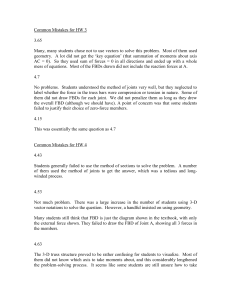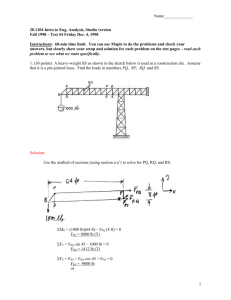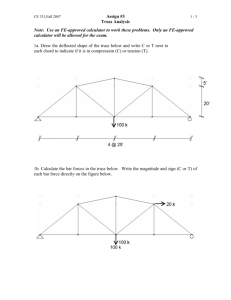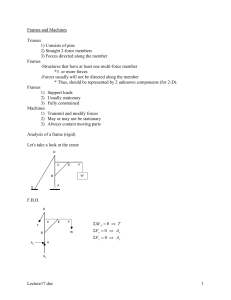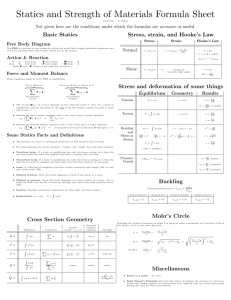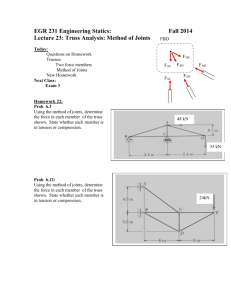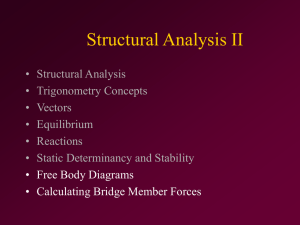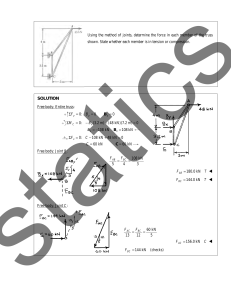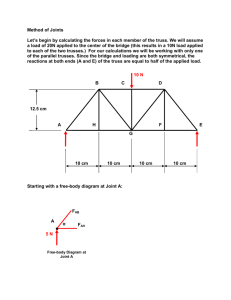Truss Analysis: Method of Joints - Lecture Notes
advertisement
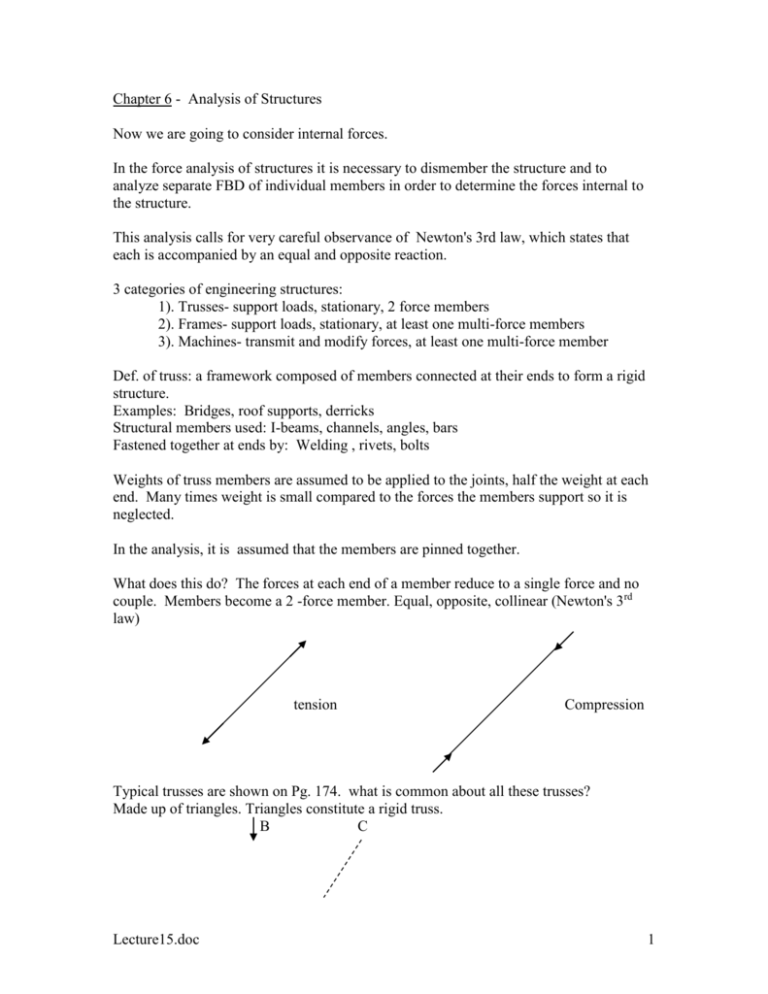
Chapter 6 - Analysis of Structures Now we are going to consider internal forces. In the force analysis of structures it is necessary to dismember the structure and to analyze separate FBD of individual members in order to determine the forces internal to the structure. This analysis calls for very careful observance of Newton's 3rd law, which states that each is accompanied by an equal and opposite reaction. 3 categories of engineering structures: 1). Trusses- support loads, stationary, 2 force members 2). Frames- support loads, stationary, at least one multi-force members 3). Machines- transmit and modify forces, at least one multi-force member Def. of truss: a framework composed of members connected at their ends to form a rigid structure. Examples: Bridges, roof supports, derricks Structural members used: I-beams, channels, angles, bars Fastened together at ends by: Welding , rivets, bolts Weights of truss members are assumed to be applied to the joints, half the weight at each end. Many times weight is small compared to the forces the members support so it is neglected. In the analysis, it is assumed that the members are pinned together. What does this do? The forces at each end of a member reduce to a single force and no couple. Members become a 2 -force member. Equal, opposite, collinear (Newton's 3rd law) tension Compression Typical trusses are shown on Pg. 174. what is common about all these trusses? Made up of triangles. Triangles constitute a rigid truss. B C Lecture15.doc 1 Not rigid A D Simple Truss: add 2 new members, attach them to separate existing joints and connect them at a new joint. B D Total # of members, m m=2n-3 n=total # of joints A C Analysis of trusses by the method of joints Let's look at the following plane truss C A RA D F B RB Dismembering C D A RA B F RB Lecture15.doc 2 Notice Newton's 3rd law between the pin and member equal and opposite Since the entire truss is in equilibrium, each pin is in equilibrium. Truss contains n Pins => 2n equations (x, y) Remember: m=2n-3=> 2n=m + 3 Thus 2n or m=+3 unknowns may be determined m => all the forces in the members 3 => R Ax , R Ay , and RB The entire truss is a rigid body in equilibrium thus we can write the following equation for the entire truss. Fx 0 F y 0 M 0 These contain no new information and so are not independent. But we can use these to determine reactions at the supports. The arrangement of pins and members in a simple truss is such that it will always be possible to find a joint involving only 2 unknown forces. Once these forces are determined their values are transferred to adjacent joints and this joint is analyzed. This is repeated until all the unknown forces are determined. Lecture15.doc 3 Examples 1). Given: the following truss 450 lbs B A 10 " C 7.5 " 24 " Find: using the method of joints, find the force in each member, state compression or tension. Ay Ax 450 lbs M A 0 Fx 0 B C y (7.5) 450(31.5) 0 Ax 0 A C y 1890 lbs y Fy 0 C x Ay 450 1890 0 Ay 1440 lbs Cy Joint B 450 lbs FAB B FBC Fy 0 Fx 0 450 FBC sin 0 FAB FBC cos 0 10 450 FBC 2 2 24 10 0 FAB 1170( 24 26 ) FAB 1080 lbs 26 FBC 450( 10 ) FBC 1170 lbs Lecture15.doc 4 FBC These are forces on pins! Forces on members are: FAb FAB BC in Compression AB in Tension FAB 1080 lbs T FBC FBC 1170 lbs C Joint A 1440 A 1080 FAC F y 0 1440 FAC sin 0 10 FAC 2 2 7.5 10 FAC 1440( 1210.5 ) 1440 FAC 1800 lbs C Check: Fx 0 1080 1800 cos 0 1080 1800( 127..55 ) 0 00 Lecture15.doc 5 2). Given: the following truss 5kn 20kn A 5kn B C 1.6m D E F 3m 3m 12kn Find: Using the method of joints, determine the force in each member, state compression, or tension. F.B.D. 5 kN 20 kN A B 5 kN C y D E F Fx x Dy Fx 0 Fx 0 12 kN Fy M F 0 Fy 0 12(3) 20(3) 5(6) D y (6) 0 5 20 5 12 21 Fy 0 D y 21 kN Fy 21 kN Joint A Fx 0 5kn FAB 0 F y 0 FAD 5 0 FAD 5 kN C FAB FAD Lecture15.doc 6 Joint D FBD 5 kN FDE 21 kN F y 0 21 5 FBD sin 0 Fx 0 1 .6 FBD 2 2 1. 6 3 FBD 16( 13..64 ) FBD cos FDE 0 16 FDE 34( 33.4 ) FDE 30 kn FDE 12 kN T FBD 34 kN FBD 34 kN C Joint E Fy 0 FBE FBE 12 0 30 kN FEF 12 kN FBE 12 kN FBE 12 kN T Truss and loading is symmetrical about the centerline. FBC FAB 0 FBF FBD 34 kN C FCF FAD 5 kN C FDE 12 kN T Lecture15.doc 7

